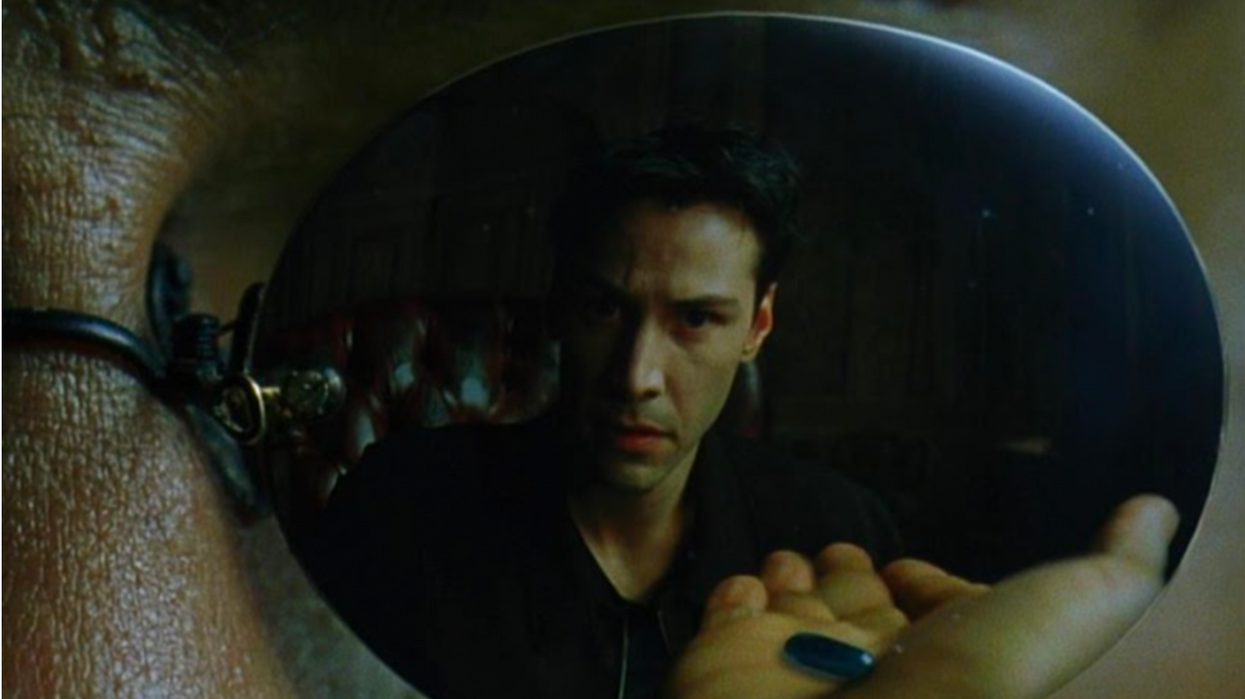Watch: What Does 'The Matrix' Owe Plato?
The famed sci-fi trilogy leans on philosophy more than you might think.

The Matrix holds a controversial place within the pantheon of sci-fi greats. While the first entry in the trilogy is largely lauded as a masterpiece, the two sequels were so ill-received that many fans changed their tune on the franchise in its entirety; the confusing writing and wooden performances in Reloaded and Revolutions were just too much for some to overlook. So, who's to blame? Plato, obviously.
Okay, that might be a bit of a stretch. Perhaps it's better to place blame on the Wachowskis' incredible ambition to compose such an all-encompassing study of philosophies. There may have been just too much to fit into a typical Hollywood formula. But, as Film Radar argues in their latest video essay The Matrix | Perennial Philosophy, we should all at least be grateful that they tried.
Film Radar points out that the first film is largely a crash course in epistemology—theory of knowledge, or the investigation of what distinguishes justified belief from opinion—especially with regard to its methods, validity, and scope. The Matrix's world, whose inhabitants are constantly questioning the nature of their reality, is easily compared to Plato's allegory of the cave.
In the allegory, Plato likens the uneducated to prisoners chained in a cave, unable to turn their heads. All they can see is the wall of the cave. Behind them burns a fire. Between the fire and the prisoners, there is a raised wall, along which puppeteers walk, carrying objects or puppets "of men and other living things." The prisoners cannot see anything happening behind them; they are only able to see the shadows cast upon the cave wall. The sounds of people talking echo off the walls and the prisoners believe these sounds come from the shadows.
Sounds kind of like the world the machines set up as the matrix, don't you think?

When one of the prisoners eventually escapes the cave in Plato's Analogy of the Sun, he is finally able to see things for how they are. The analogy acts as a commentary about the nature of reality and which steps a human must take to fully realize it. For Neo in The Matrix, it was pretty easy. All he had to do was take the red pill.
Having successfully pulled off epistemology in the first film, the Wachowskis looked to the second and third to deal with Eastern philosophy, primarily the focused on "samsara," which Film Radar defines as the cycle of death and rebirth to which life in the material world is bound.
In case you weren't quite able to catch this pivotal plot point through the Architect's overkill fancy-pants dialogue, there had been five previous versions of the Matrix prior to the one Neo lived in during The Matrix Reloaded. In that sense, there were also five prior versions of Neo, and five prior versions of Zion. In all previous versions, an anomaly eventually emerges in the form of "The One" whose path leads him to the architect. Zion is destroyed, the matrix is rebooted, and The One takes with him 23 people to rebuild Zion. Every other chosen one has made the same choice because failure to comply will kill everyone, effectively wiping out humanity.

This tidbit of information has been made relevant recently once again, as news has been circulating of a Matrix reboot. Many think that instead of merely remaking the original franchise, the focus should be put on stories from the five earlier iterations of "The One." (This Rogue One direction definitely seems like the way to go.)
Finally, in The Matrix Revolutions, the Wachowskis turned to the Hindu concept of Brahman.
"If you look at the whole trilogy, it's really outlined," Ken Wilber explains in the documentary Return to Source: Philosophy and The Matrix. "This whole general view of body, mind, and spirit, what has to happen when they are alienated. And that it can be reunited when somebody, either the individual or a savior helping others, reconnects with spirit. That realigns all these different dimensions which make the full integrated human being. When that happens then the matrix itself is dissolved, because it’s no longer alienated."

Indeed, the concept of Brahman stresses the belief that you have to die to resurrect spirit. By defeating Agent Smith and allowing himself to die, Neo is reunited with spirit. He has identified his soul’s place within "the source" and brings the endless cycle of samsara to an end, liberating Zion in the process.
Brahman, in Hinduism, can be likened to "the source." Film Radar defines it as "the material, efficient, formal, and final cause of all that exists. It is the pervasive, genderless, infinite, eternal truth and bliss which does not change, yet is the cause of all changes. Brahman as a metaphysical concept is the single binding unity behind the diversity in all that exists in the universe."

 No Film School's coverage of
No Film School's coverage of 









